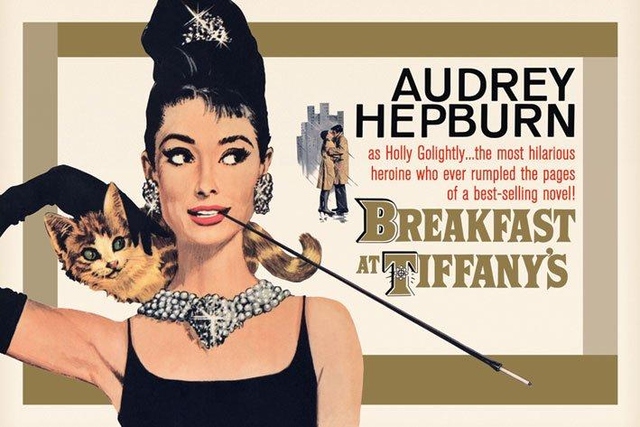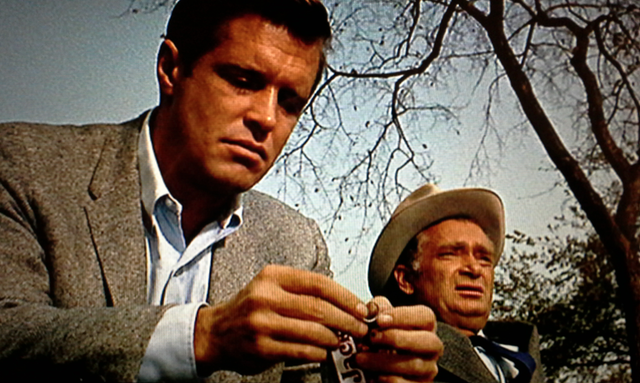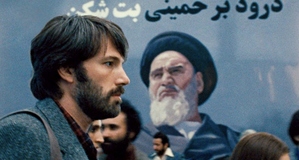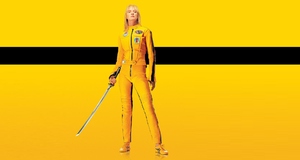Holly Golightly and the Endless Pursuit of Self-Actualization in "Breakfast at Tiffany's"
By
2014, Vol. 6 No. 09 | pg. 1/3 | »
IN THIS ARTICLE
KEYWORDS
Yes, they still have prizes in Cracker Jack boxes. Beneath the glossy surface of this timeless commodity lies a variable that provides fodder for the consumer’s imagination. Marketed as “candy coated popcorn, peanuts and a prize,” the Cracker Jack label not only promises a prize but a surprise. With each purchase, the consumer envisages an encounter with something unpredictable, in the same way that cinema was promoted as a “dream machine.” Since 1896, both the Cracker Jack box and the film industry have packaged the promise of the unexpected for the masses. By one interpretation, Blake Edwards’ comedy Breakfast at Tiffany’s (1961) conveys the disillusionment experienced when the prize of the Cracker Jack box – and correspondingly the film itself – cannot be equated with surprise. When an astute Tiffany’s salesman is presented with a ring from a Cracker Jack box, he remarks that the continued existence of such prizes “gives one a feeling of solidarity, almost of continuity with the past, that sort of thing.” In Tiffany’s, the prize does not represent the thrillingly unknown, but instead the comfortably expected: it represents the maintenance of an established tradition. Similarly, the film itself promises an “Audrey Hepburn as you’ve never seen her before” – a novel onscreen female persona – and yet such a promise of the unexpected remains ultimately unfulfilled. 
For most of the film, the irresistible, irrepressible icon that is Hepburn’s Holly Golightly signifies glamour, alluring idiosyncrasy, and nonconformity; yet by the end, much of her subversive potential has been undone. Like a Cracker Jack box, the effervescent Holly initially appears to contain a limitless set of possibilities for her interiority and trajectory, but the film’s archetypal Hollywood ending yields only the generic “prize”: the union of hero and heroine. As the story goes, the production crew of Tiffany’s opened 200 Cracker Jack boxes before discovering a ring: an anti-mimetic confirmation that the heterosexual, monogamous marriage symbolized by the ring can be Holly’s only permissible fate. The notion that Holly might sustain an identity on her own – without a male counterpart – proves illusory: the ring was in the Cracker Jack box the entire time, to be passed from her ex-husband Doc Golightly (Buddy Ebsen) to a second patriarchal protector Paul Varjak (George Peppard) (Fig. 1). Yet, crucially, for some time, the success of Holly’s self-actualized identity suggests that the filmic Cracker Jack box may hold something other than a ring. To use Laura Mulvey’s phrase, Holly might be argued to represent something besides a “signifier for the male other” for about an hour and a half in a 1961 Hollywood film – an anomaly that causes many critics to claim that Holly represents the “dawn of the modern woman” (Mulvey 7; Wasson iii). When the reflectively inevitable union of Holly and Paul transpires in the final scene, Tiffany’s upholds the status quo for female representation in a Hollywood film. This essay will ultimately argue that the film’s altogether-too-tidy endpoint exposes the mechanism by which cinema undermines a subversive onscreen female persona. Holly was a symbol of all these girls who come to New York and spin in the sun for a moment like May flies and then disappear. I wanted to rescue one girl from that anonymity and preserve her for posterity. Firstly, this essay will delve into historical context in order to articulate the aspects of Holly Golightly’s identity that are “subversive.” Secondly, a theoretical framework will be proposed to account for how this identity is momentarily attainable within this diegetic urban consumer culture. Thirdly, three sequences will be closely analyzed in order to track the transformations in Holly’s identity over the course of the film. Finally, this essay will ponder Holly’s legacy and the failure of the film to wholly undermine the project of her subversive identity. A Fugitive from the Feminine MystiqueHolly’s identity may be termed “subversive” in the sense that she transcends the codified female position of “bearer of meaning” and becomes “maker of meaning” (Mulvey 7). This onscreen woman actualizes a self that does not ascribe to contemporary filmic and extradiegetic codes of femininity. Feminist scholars have characterized the decade preceding the release of Tiffany’s as a revival of the cult of domesticity1 – a value system that effectively concretized the nuclear family in its pedestalization of heterosexuality, monogamy, marriage at a young age, and female chastity and domesticity (Wegener 36). As Marilyn Cohen argues, films of the late 1950s/early 1960s were reflective of the “should and should-nots of gender roles, expressions of sexuality, and domesticity,” thus imitating and propagating this value system (309). In an era in which social dynamics were strongly media-tempered, the “Lady” and the “Housewife” were the most prevalent female media “types,” neither of which would apply to Holly. Holly is much too idiosyncratic, and not nearly voluptuous enough, to be the “Lady” – the sexually-available product of the “mammary mania of the 1950s,” as exemplified by Jayne Mansfield and Marilyn Monroe2 (Douglas 105). Holly does not care much for contemporary codes of female domestic propriety and thus seems to be the antithesis of the (ostensibly) happily-aproned stay-at-home wife à la Barbara Billingsley in Leave it To Beaver (CBS, 1957-1963). Instead, Holly parties all night and sleeps all day, often in the nude; occasionally shoplifts for a thrill, thinks of marriage scornfully, and “can’t think of anything she’s never done.” She has redefined the domestic routine, sipping coffee in a jar at around midday and drinking champagne before breakfast. As Susan J. Douglas describes, “here was a young woman on her own, flouting all sorts of old-biddy conventions about how single women should conduct themselves, having a ball” (105). In one scene, Holly tells Paul that it is “lucky that you’re not rich enough to marry” and then proceeds to kiss him, thus wholly content to participate in an uncommitted relationship. As numerous critics have previously argued, Holly represents something new for female representation in Hollywood cinema – a surprise within the filmic Cracker Jack box. What exactly this metaphorical box might contain has been a source of impassioned discussion among critics. According to Douglas, Holly challenged contemporary codes for femininity by making “female eccentricity, and deliberately not fitting in, glamorous,” and by validating young women’s “emerging antagonism to the institution of marriage” (106). Similarly, Sam Wasson argues that Hepburn’s star persona allowed for Holly to represent a reconfiguration of acceptable social codes: “because Audrey was doing it, living alone, going out, looking fabulous, and getting a little drunk didn’t look so bad anymore. Being single actually seemed shame-free. It seemed fun” (xvii). Pamela Robertson Wojcik considers Holly’s most important characteristic to be the successful transformability of her identity: “Holly’s is a story of constantly leaving and remaking herself … [yet] her rootlessness speaks glamour and sophistication” (142-3). A synthesis of these critical perspectives conveys that Hepburn’s character manifests a fantasy among contemporary young women of transcending social codes and strata, and achieving a quirky, yet appealing, independence. Thus, the Cracker Jack box – which eventually and inevitably contains marriage – seems to contain forces that threaten to disrupt what Elaine Tyler May dubs the “sexual containment policy”: a series of “efforts to achieve sexual repression, [of which] marriage was considered to be the appropriate container for the unwieldy American libido”3 (101, 117). Irrespective of whether Holly was a prostitute or an “American geisha,” she rejects sexual containment and participates in an urban lifestyle of relative sexual autonomy (Inge 141). For the young American female viewer, Tiffany’s narrative trajectory initially seems to demonstrate that such a fantasy of increased autonomy can be realized. For Holly, the parties have not always gone until dawn and the shoes have not always been stored in a vase or refrigerator: she is a fugitive from Betty Friedan’s “feminine mystique.” She has left behind the identity of Lulamae Barnes, who was married in Tulip, Texas at the age of 13, to pursue her own self-actualization as a woman. As Lulamae Barnes, Holly epitomizes the late 1950s trend in early marriage for women: “by the end of the 1950s, the average marriage age of women in America dropped to 20, and was still dropping into the teens. Fourteen million girls were engaged by 17” (Friedan 16). As if responding to Friedan’s appeal in The Feminine Mystique (1963) for women to “no longer ignore that voice within women that says: ‘I want something more than my husband and my children and my home’,” Holly travels to New York City to become her own breadwinner (32). Here, she seeks to reach her full – and subversive – potential through independence, spontaneity, creativity and a personal understanding of urban culture. She has rejected being actualized by her husband Doc Golightly, as well as her agent O. J. Berman, who pays for her French lessons and dresses her up to be a movie star. To the latter, she says, “When I find out what I want, I’m going to let you know.” Alone in New York City, Holly has begun to author her own existence.Continued on Next Page » Suggested Reading from Inquiries Journal
Inquiries Journal provides undergraduate and graduate students around the world a platform for the wide dissemination of academic work over a range of core disciplines. Representing the work of students from hundreds of institutions around the globe, Inquiries Journal's large database of academic articles is completely free. Learn more | Blog | Submit Latest in Film & Media |



















